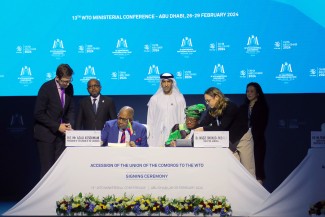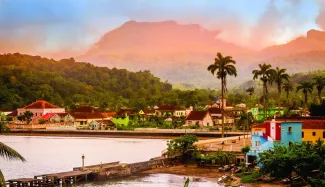Rosalie’s day starts at 4 a.m., kneading coconut cream rolls with her eldest daughter to sell at the local community shop down the road from her house. As with the rest of her day, it begins with collaboration.
“We all take part together to do the work at home like making breakfast, grating the coconut. I teach my kids how to do different things at home. At the end of it they receive the cash and put it in the bank. It makes them happy,” she says.
She continues, walking along the seafront to her day job as an arts and handicrafts trader, or ‘market mama’ as they are colloquially referred to in Vanuatu. Rosalie’s stall is full of white t-shirts with colourful island life scenes hand painted on them, kaleidoscopic island dresses, intricately woven baskets and timber carved in all shapes and sizes.
Rosalie is not just any market mama. She is the founder of Bulvanua Arts & Handicrafts – a cooperative of 30 traders who are promoting Made in Vanuatu products in place of imported products.
“Most of the women who are in the business of selling arts and handicrafts are actually selling imported products,” Rosalie says.
"The reason for this is complex," says Willie Luen of Vanuatu’s Ministry of Tourism.
Over the last 10 years, Vanuatu has become an increasingly popular tourist destination. The number of international visitors has increased by 42%, tourism now employs 55% of Vanuatu’s total labour force and represents 65% of Vanuatu’s GDP.
At the same time, foreign-owned hotels have been springing up across the main island, luring tourists to spend the majority of their time and money in these venues rather than in local markets.
“To be competitive many of the traders began to rely on more cheaply priced imports, which then depressed Vanuatu's own production,” says Willie.
“Profits were leaving the country as quickly as they arrived. So, the key to retaining the benefits of tourism was to be found in sourcing local products and presenting these to tourists, preferably outside the hotel environment.”
An opportunity to solve this problem presented itself in a meeting about redeveloping of the capital city’s seafront.
“We were convinced that the new seafront could provide an opportunity to better showcase local goods to tourists and provide much-needed stimulus to the local economy,” says Luen.
Crucially, the redeveloped seafront area creates much stronger linkages for tourists to Vanuatu-made products and services.
In March 2015, the market and the industries dependent upon it were nearly completely decimated when Cyclone Pam swept through Vanuatu, destroying 90% of buildings on the main island including homes, market infrastructure and ports.
“We had to relocate temporarily and during that time it was really sad for us because we lost our businesses,” says Rosalie.
With the help of the New Zealand government and the Enhanced Integrated Framework, Vanuatu completed the seafront redevelopment in September 2017, turning it into an attractive area for locals and visitors alike. The mamas handicraft market was rebuilt with added power and internet, and local expertise was employed in creative ways.
“We hired some local carvers and they’ve created sculptures which are now displayed in the seafront area. The business exposure they’ve gained through this has helped improve their living standards,” Luen says.
As tourist arrivals increase by a projected 36%, and the mamas turn to local producers, a broad supply chain is developing that promises to improve the lives of ni-Vanuatu people far beyond the sellers seen at the seafront.
The impact on the lives of ordinary people here has been marked, according to Luen.
He speaks of a highly visible change that is at least party owed to the redevelopment project: new and better houses, schools filling with children and markets, specifically the Port Villa Seafront, busy with activity.
“One of the carvers recently told me that because people see his works on the seafront and are contacting him for orders, he now has enough income to send his daughter to school,” Luen says.
In her work to better connect local producers and traders, Rosalie is already seeing the change.
“[Tourists] are no longer going back to the shops where all the imported products are,” she says.
“I see the opportunities that men and women of Vanuatu can do out of the local resources around them. With busy hands, they can create something to help Vanuatu to build its economy.”
“All the people of Vanuatu are really happy and glad to see this.”
If you would like to reuse any material published here, please let us know by sending an email to EIF Communications: eifcommunications@wto.org.


